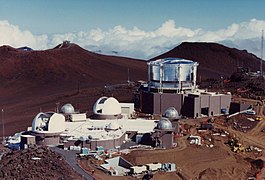Haleakalā Observatory
 Haleakalā Observatory with DKIST (left) and AEOS Telescope (right) | |
| Alternative names | Haleakala Observatory |
|---|---|
| Organization | |
| Location | Haleakalā, Hawaii, United States |
| Coordinates | 20°42′30″N 156°15′26″W / 20.7083°N 156.2571°W |
| Altitude | 3,052 m (10,013 ft) |
| Established | 1961 |
| Website | about |
| Telescopes | |
| | |
The Haleakalā Observatory, also known as the Haleakalā High Altitude Observatory Site, is Hawaii's first astronomical research observatory.
Facilities
Mees Solar Observatory
The Mees Solar Observatory (MSO) is named after Kenneth Mees and dedicated in 1964.[1] It consists of one dome with multiple instruments sharing a common mount.[3]
Pan-STARRS
The
Faulkes Telescope North
The
TLRS-4 Laser Ranging System
The TLRS-4 Laser Ranging System is part of the
Zodiacal Light Observatory
The Zodiacal Light Observatory currently consists of two instruments. The Scatter-free Observatory for Limb Active Regions and Coronae (SOLARC or SOLAR-C) telescope is a 0.5 m (20 in) off-axis reflecting
Maui Space Surveillance Complex
The
Daniel K. Inouye Solar Telescope
The Daniel K. Inouye Solar Telescope (DKIST) is a 4.0 m (160 in) solar telescope of the National Solar Observatory.[14][15]
Future facilities
- The AFRL has plans to build a mirror re-coating facility adjacent to the AEOS building.[13]
Former facilities
- A Baker-Nunn telescope operated from 1957 to 1976 as part of Project Space Track.[16]
- The Lunar Ranging Experiment (LURE) Observatory operated from 1974 until 2004.[16] The Pan-STARRS PS1 now resides in the south dome of the LURE facility and the PS2 is being built in the north dome.
- The University of Chicago Enrico Fermi Institute operated the Haleakala Cosmic Ray Neutron Monitor Station from 1991 to 2007.[16][17]
- The Haleakala Gamma Ray Observatory was a six-mirror Imaging Atmospheric Cherenkov Telescope on an equatorial mount. It began operating in 1981 and was upgraded in 1988.
- The near infrared telescope operated by the University of Tokyo.[18] It was housed in the LURE facility's north dome from 1998 to 2008.[16]
- Observations of airglow were made from a platform near the middle of the site in the 1960s and 1970s. The platform is now used for temporary projects.[13]
- The Near-Earth Asteroid Tracking (NEAT) program operated from 2000 to 2007 using one of the MSSS 1.2 m telescopes.
Non-astronomical facilities
- The Federal Aviation Administration operates a facility immediately to the west of the observatory site.[16]
- The Department of Energy also operates a facility immediately to the west of the observatory site.[16]
- A small building on the site is used by the Haleakalā Amateur Astronomers.[16]
Gallery
-
Air Force facilities from the west
-
AEOS telescope
See also
References
- ^ a b "IfA Maui History". University of Hawai‘i Institute for Astronomy. Retrieved 2012-01-09.
- doi:10.1086/497622.
- ^ "Haleakala Observatories". University of Hawai‘i Institute for Astronomy. Retrieved 2012-01-09.
- ^ "NEO Discovery Statistics". NASA.
- ^ "Project Status - Pan-Starrs - Panoramic Survey Telescope & Rapid Response System". University of Hawai‘i Institute for Astronomy. Retrieved 2012-01-09.
- ^ "About Us | Faulkes Telescope Project". Faulkes Telescope Project. Archived from the original on 2012-01-25. Retrieved 2012-01-09.
- ^ "About ILRS". International Laser Ranging Service. Archived from the original on 2012-01-22. Retrieved 2012-01-09.
- ^ "TLRS-4 Laser Ranging System". University of Hawai‘i Institute for Astronomy. Retrieved 2012-01-09.
- ^ "Institute for Astronomy Solar-C". University of Hawai‘i Institute for Astronomy. Retrieved 2012-01-09.
- ^ "Day - Night Seeing Monitor DNSM Telescope System". University of Hawai‘i Institute for Astronomy. Retrieved 2012-01-09.
- ^ "Fact Sheets: AFOSR: AEOS at AMOS". Air Force Research Laboratory. Archived from the original on 2012-01-21. Retrieved 2012-01-09.
- ^ "Air Force Maui Optical and Supercomputing Site". Air Force Research Laboratory. Archived from the original on 2005-08-28. Retrieved 2012-01-09.
- ^ a b c "Haleakalā High Altitude Observatory Site Long Range Development Plan" (PDF). University of Hawai‘i Institute for Astronomy. January 2005. Retrieved 2012-01-09.
- ^ Joseph McMullin; Thomas Rimmele (2012-11-14). "NSO Announces Start of ATST Site Construction" (Press release). National Solar Observatory.
- ^ "Frequently Asked Questions | DKIST". National Solar Observatory. Retrieved 2018-12-03.
- ^ a b c d e f g "Haleakalā High Altitude Observatory Site Management Plan" (PDF). University of Hawai‘i Institute for Astronomy. 2010-06-08. Retrieved 2012-01-09.
- Bibcode:1993ICRC....3..609P.
- Bibcode:2003AAS...202.3803Y.
External links
- University of Hawaii Institute for Astronomy - Haleakala Observatory
- "Maui's Night Sky" Time elapse photography of night sky from Haleakala by Wally Pacholka. Maui No Ka 'Oi MagazineVolume 14, Number 3 (May 2010)
- Historic American Engineering Record (HAER) No. HI-118, "Reber Circle, Grote Reber Radio Telescope Site, Pu'u Kolekole Hill, Pukalani, Maui County, Hawaii", 6 photos, 10 data pages, 2 photo caption pages



